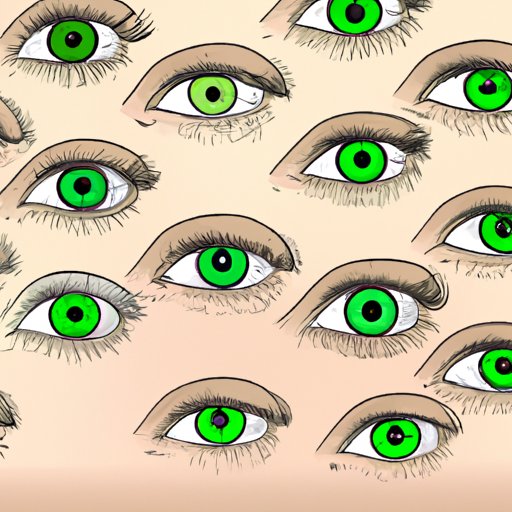I. Introduction
Green eyes are a rare and intriguing phenomenon that has piqued the curiosity of people for centuries. Whether it’s the subject of admiration, fascination, or even skepticism, green eyes have a mesmerizing quality that distinguishes them from other eye colors. While they might seem like a mystical and mysterious enigma, the truth is that green eyes are the result of scientific factors, genetics, and culture.
In this article, we will explore green eyes in-depth, uncovering their genetic and biological mechanisms, debunking common myths and misconceptions, and examining their cultural significance. From statistics to symbolism, we aim to provide comprehensive insight into this striking eye color.
II. Exploring the Genetics of Green Eyes: Understanding Probability and Prevalence
The color of your eyes is determined by the amount and distribution of melanin in the iris- the colored part of the eye. Melanin is a pigment that also influences skin and hair color. While everyone has melanin in their eyes, it is the amount and distribution of it that determines the eye color.
Green eyes are the result of a combination of genetic factors. Eyes with low melanin content appear blue or green, while those with a higher melanin content are brown or black. The green color comes from a combination of low melanin content and the scattering of light in the iris. This is known as the Tyndall effect.
Green eyes are relatively uncommon, with only 2% of the world’s population having them. They are most prevalent in Northern and Central Europe, with Iceland, Ireland, and Scotland having the highest concentration. In contrast, people of Asian, African, and South American descent rarely have green eyes.
III. Green Eyes: Myth vs. Reality
Green eyes have long been associated with mystical and supernatural powers. From being a sign of good fortune to a curse, there are many myths surrounding this eye color. However, many of these are far from reality. For example, green eyes are not an indication of special powers or talents, nor are they the rarest eye color, as popular culture often suggests.
Green eyes are unique, but they are not a mythical or magical trait. They are simply a genetic variation that has evolved over time. In fact, green eyes are just as natural as brown, blue, or grey eyes.
IV. The Science Behind the Color: Why Some People Have Green Eyes
The color of green eyes comes from a combination of biological factors. Low melanin content is a primary factor, but the presence of other pigments, such as lipochrome, can also influence the color. Lipochrome is a yellow pigment that is present in the iris, and its combination with the blue scattering of light creates the green hue.
The amount and distribution of melanin and lipochrome in the iris determine the specific shade of green, from light green to deep emerald green. Additionally, green eyes can appear greener or bluer depending on the lighting and surroundings.
V. Breaking Down the Data: How Many People Worldwide Have Green Eyes?
As mentioned earlier, only 2% of the world’s population has green eyes. However, there are variations in prevalence depending on the region or population. For example, in some areas of the Middle East, such as Iran and Pakistan, up to 5% of the population may have green eyes. In contrast, green eyes are extremely rare in East Asia, with less than 1% of people having them. age is also a factor, with green eyes more common in younger people compared to the elderly.
The distribution of green eyes can be influenced by genetic factors, as well as environmental factors, such as climate, migration, and colonization. For instance, European explorers and colonizers brought green eyes to other parts of the world, leading to pockets of green-eyed individuals in South America and Australia.
VI. Cultural Significance and Symbolism of Green Eyes in Different Parts of the World
Green eyes have different cultural meanings and symbols depending on the region and tradition. In many Western societies, green eyes are often associated with beauty and desirability, especially in women. They are frequently featured in fashion, media, and entertainment as a sign of allure and mystery.
However, green eyes can also be stigmatized or associated with negative connotations in some cultures. In certain Middle Eastern and South Asian countries, green eyes are considered unnatural and even evil, with some associating them with jinn or demons.
In Irish folklore, green eyes indicate that a person has fairy blood, connecting them to the mystical and supernatural realm. Meanwhile, in Japan, green eyes have links to the samurai class, who were known for their loyalty and bravery.
VII. Green Eyes in History: Famous Personalities with Emerald Eyes and Their Impact
Throughout history, there have been many famous personalities with green eyes who have made a significant impact on society and culture. From artists to writers, actors to activists, green eyes have been a part of their identity and legacy.
Some of the most well-known personalities with green eyes include Elizabeth Taylor, who was famous for her striking violet-green eyes, and singer Rihanna, whose green eyes are a standout feature. Historically, figures such as Cleopatra, Catherine the Great, and William Shakespeare are believed to have had green eyes, which have influenced their representation and portrayal in art and literature.
VIII. Conclusion
Green eyes are a unique and fascinating feature that offers an insight into our biological makeup and cultural history. While they may be rare, they are not a mythical or magical trait, but rather a genetic variation that has evolved over time. Understanding the genetics and mechanisms behind green eyes, as well as their cultural significance, helps us appreciate this captivating eye color and the diversity of the human experience.
Next time you come across someone with green eyes, take a moment to appreciate the beauty and depth that lies within them.
